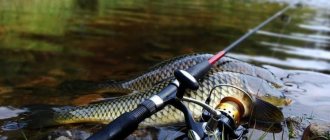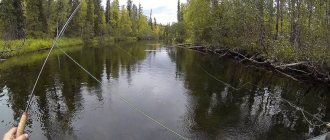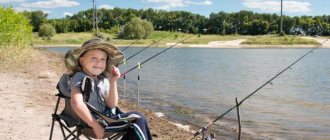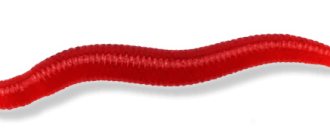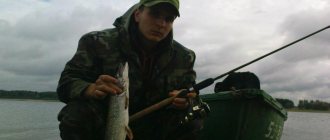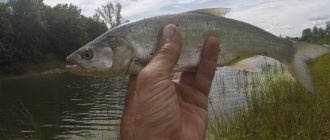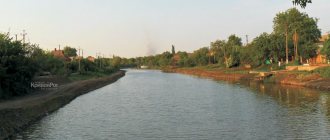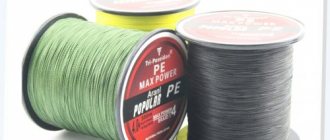There are main places where predators hunt for fry:
- A powerful stream of a river bed hitting or moving away from a bank.
- Pits or pools with snags and fallen trees are the favorite resting places for large ide.
- He goes hunting closer to the shore or in shallow water.
- On a lake or pond, it should be looked for on the edges between ditches and holes. If a hole or old channel runs between the islands, this place should be fished first.
The ide prefers a hard bottom than a muddy bottom.
Shallow water is a hunting ground for small ides. They sit in holes and wait for small fish to appear. But it will also react to small bait moving along the bottom. Even if you find a fishing spot where there are “fish”, you may be left without a catch, not knowing the right baits for this fish.
Technique for catching ide with a spinning rod
When fishing from the shore, it is better to examine the ide’s favorite hunting spots. When fishing in an unfamiliar body of water, you should look for holes and pools. Pay attention to the color of the water. In deep places the color will be darker. You can trawle the bottom with a fishing line and a sinker.
If you get into a hole, it will become a little harder to turn the reel and the line will weaken. This is how we determine the bottom topography. Having found out the places, we begin fishing. Different wiring should be used when changing types of spinners.
Catching ide in the summer from a boat is the main way of good fishing. At this time, the predator actively hunts small mounted fish. “Cauldrons” are formed. A flock of predators beats fish, huddled in one place.
Advice! When fishing for boilers, casting should be done along the edge of the school. In this way the fish are not scared away. With such a cast, the outermost individuals may be frightened, but the rest will be attracted by the play of the bait.
Fishing Features
The ide is very similar to another more popular representative, which is caught on an ultra-light spinning rod, the chub. It also has an elongated, slab-like body with bright red fins and covered with silvery scales. However, these fish still differ from each other and are independent species.
This is a large fish, capable of reaching up to 7–8 kg. Of course, you probably won’t find such specimens in our time. Mostly, the catches of spinning anglers include ides weighing from 0.5–1.5 kg, and catching an individual weighing 2–3 kg is considered a real success and happens once in a lifetime for some fishermen.
Photo 1. Quite a large ide, a trophy specimen.
Ide is an omnivorous underwater inhabitant. Its diet is very varied and depends on the time of year and the reservoir itself. It consists of plant and animal foods:
- filamentous algae;
- benthic invertebrates;
- small crustaceans;
- larvae of semi-aquatic insects;
- beetles, dragonflies, butterflies and other insects;
- river mollusks and shells.
The ide also feeds on small fish. It is difficult to say for sure what this is connected with. Perhaps this is how his predatory instinct manifests itself, or perhaps he simply drives away competitors from his favorite places. In any case, it is caught with a spinning rod and at times very well.
When to catch ide with a spinning rod?
You can start hunting for ide with a spinning rod in early spring. Experienced fishermen manage to catch this predator immediately after the water bodies are cleared of ice. The first fish bites begin at the beginning of the spring flood, when the water is just beginning to rise, raising the river level.
The early spring activity of ide can hardly be called a zhor, but from time to time it is possible to catch this fish well, earning a lot of bites and catching a lot of weighty fish. The predator then goes to spawn when it completely stops feeding and is not hooked.
To spawn, ide rises to the upper reaches of rivers and can enter small tributaries and streams. It is characteristic that this fish does not lay eggs in shallow water. To do this, he chooses quiet places with a hard bottom, uneven terrain and medium depths.
Having laid eggs, the fish stays near the spawning grounds for some time, where it gradually recovers from the process of prolongation of the genus and begins to feed. As the water warms up, the ide rolls off to its usual summer places. This coincides with the moment the cockchafer takes flight, which is marked by the start of the spring feeding of this fish.
With the onset of summer, ide occupies the upper horizons of water.
Now the predator picks up insects that have fallen into the water from trees and bushes, and also actively eats up aquatic vegetation. During this period, it is caught with baits that work either on the surface or at depths not exceeding half a meter. Advice!
In summer, ide is active in the evening hours. Sometimes he is caught even at night. At the end of summer, ide shows a surge in activity. The fish, like the chub, responds very positively to the offered baits, greedily attacking them. During this period, the predator stands in the water column and rarely rises to the surface. This stage continues until the end of Indian summer, when stable, cool autumn weather sets in.
With colder weather, the ide “enlarges” its groups and descends to deeper areas with a slower flow. Now it is becoming difficult to catch him with a spinning rod. You will need specialized baits and a thorough knowledge of the reservoir to detect active fish.
Where to catch ide with a spinning rod?
Ide is a river underwater inhabitant. It is found both in small streams and in deep arteries. This predator also inhabits reservoirs, deep lakes and clean quarries in large numbers. This fish rarely lives in places with stagnant water, although in the northern regions it is successfully caught in closed reservoirs.
Typical areas on rivers where there is the greatest likelihood of catching ide are:
- long ditches with medium depths;
- slopes, slopes and edges, where you can hide from the current and it always brings a lot of food;
- snag and well;
- rocky ridges with ripple streams;
- bridge supports and other hydraulic structures;
- rifts and braids.
In summer, a lot of ide can be found under the overhanging branches of bushes and trees. Here the fish picks up insects falling into the water: butterflies, beetles, dragonflies and other living creatures. In addition, in the shade you can hide from the scorching sun and comfortably spend a hot day.
In summer, if you approach the edge of a steep bank, you can also observe flocks of different-sized ides. The predator loves steep rivers because there is a lot of food here, and you can hide from strong flows in various depressions and pockets.
In some areas, ides may be mixed with chubs. This can be observed on rifts, under steep ridges, in snags or near bridge supports. These species practically do not compete with each other and individuals of approximately the same size accumulate in a particular place.
When to start?
You can start catching ide with a spinning rod in early spring. Experienced fishermen fish out these predators as soon as the ice melts. The spring flood is considered a period of successful bites. Despite the fact that the ide does not get hungry in the spring, at this time, judging by numerous reviews, you can do some good fishing. Next, the predator enters a spawning period, and bites occur much less frequently. According to experts, ide does not lay eggs in shallow water. Therefore, during spawning, it rises to the upper reaches of rivers. The fish are stationed in quiet, mid-depth places. After laying eggs, the predator remains near the spawning ground for some time, but slowly seeks food for itself. Judging by the reviews of fishermen, ide bites best on a spinning rod in the summer. At this time, the predator stays in the upper horizons of the water. It feeds on aquatic vegetation and fallen insects. In summer, on the river, fishing for ide with a spinning rod is carried out using baits at a depth of no more than 50 cm or on the surface itself. Beginners often ask the question: at what time of day will fishing be most effective? According to experts, it is best to start fishing for ide with a spinning rod in the late evening. Some fishermen advise fishing at night.
Monofilament or braid?
In the confrontation between monofilament and braided threads in the case of catching ide, there is a noticeable superiority of the cord. The lack of stretch allows the angler to feel any change in the action of the bait. In addition, thanks to the braid, it is possible to timely see the moment of a bite from a passive fish.
Read! Features of fishing with popper
However, when fishing at short distances, nylon fishing line can be used successfully. The use of monofilament is also justified when lighting the water, when the fish are wary of the braided thread.
About fishing technique
For those who do not know how to catch ide with a spinning rod, experts recommend considering the following:
- Due to the fact that ide is predominantly not stationed in an open area, using a spinning rod, the fisherman should first of all pay attention not to the range, but to the accuracy of casting. The matter is complicated by the fact that ide baits, due to their low weight, do not have good flight qualities.
- Casts are made at a distance ranging from 20 to 30 m.
- Wiring should be done as slowly as possible.
- It is better to fish the near zone at the very beginning. Otherwise, fishing for fish from long distances will scare away the ides that are nearby.
- Casting is performed from two directions: against and downstream.
Lures
Catching ide with a spinning rod is carried out using wobblers and back-loaded rotating brass or copper spoons. Preference should be given to multi-colored or golden and silver shades. The ide practically does not bite on one-color baits. Among the wide range of different wobblers, experts recommend paying attention first of all to cranks. These baits, judging by numerous reviews, are the most versatile and work equally effectively from late spring to early autumn. Minnows and shads have also proven themselves well. Micro-oscillators are very popular among fishermen. Initially, these baits were used by trout fishermen. However, spoons have proven to be very effective in catching many other river predators. Despite the fact that “spinners” are no longer in such demand lately, experienced fishermen advise taking spinners with them to the pond. Many fishermen catch ides using dry baits in the form of black beetles and butcher flies.
Ide habitats
You should look for the handsome redfin in rivers of various sizes, large lakes and reservoirs.
This fish loves clean water with a fairly rich oxygen content. Depending on the time of year, ide can occupy different areas in the reservoir. The best points for catching ide are:
Each specific ide habitat requires appropriate bait and wiring. As for the best time for fishing with a spinning rod, many anglers prefer the autumn harvest. In spring, there is a good bite until the water level drops, which coincides with the days of May.
About the rod
They catch ide with a spinning rod. According to experts, the tackle must be light, since only miniature baits are used for bites. On the shelves of specialized stores there are various ultralight rods, reels and lines designed for catching ide. When choosing a fishing rod, you should take into account its test indicator. As experienced fishermen recommend, the test of a spinning rod for ide should not exceed 20 g. If there is a high probability of catching an ide that is too large with a spinning rod, then you should get a more powerful rod. In this case, the fisherman can fight the river predator without worrying about the safety of the gear. When choosing the length, you should take into account the width of the reservoir itself. The optimal size would be a spinning rod, the length of which is 2.10 m. Judging by numerous reviews, such tackle is ideal for small rivers and large deep arteries. For cramped conditions, 1.8-meter rods are recommended. If a fisherman plans to fish using long casts, then he should acquire a spinning rod, the length of which varies from 2.4 to 2.7 m. It will be possible to successfully dampen the jerks of the ide if the spinning rod has a decent margin of safety.
